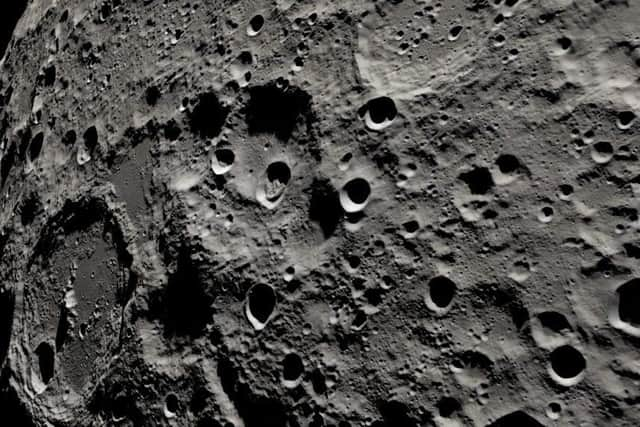The John Griff column: To boldly go - the routine of spaceflight
and live on Freeview channel 276
The story of the Apollo 13 crew – Jim Lovell, Fred Haise and Jim Swigert, grabbed the world’s attention, but in a way that nobody had expected or wanted it to. NASA had already landed Neil Armstrong and Buzz Aldrin on the surface of the moon the previous year – and brought them safely back to earth with fellow astronaut Michael Collins. The mission had delivered against John F Kennedy’s challenge a decade before, earning it the epithet of being, arguably, mankind’s greatest technical achievement. Then, the world had sat enthralled by its television sets, watching grainy, heavily lined live pictures beamed from the moon’s surface. Just months later year as part of the wider ongoing programme to put astronauts on the moon and pave the way for a permanent base there, Apollo 13 had been on its way to what should have been another landing – the third. But the world had moved on. Familiar with the programme’s aspirations and critical of the vast costs associated with each successive moonshot, the US public had become increasingly ambivalent to NASA’s activities, however forward thinking they might have been. Very few had taken any notice of the tiny spacecraft as it hurtled towards the moon.
That all changed on the 13th of April 1970.
After a routine procedure as part of their flight, the crew of Apollo 13 found their lives put in very real jeopardy as an oxygen tank exploded, taking a large part of the spacecraft and most of its oxygen with it. Armstrong’s now immortal words ‘That’s one small step for man… one giant leap for mankind’ were joined by Swigert’s: ‘...Okay Houston, we’ve had a problem here…’.


Advertisement
Hide AdAdvertisement
Hide AdIn the instant that the news broke, the world’s attention switched to any and every news outlet carrying the story. Instead of technical excellence, it was of the unthinkable but very real prospect of three of America’s finest being suddenly condemned to die in the icy vacuum of space through a combination of oxygen starvation and a buildup of carbon dioxide – effectively suffocating themselves. Responding to the dilemma of what to do, NASA scrubbed the intended mission and starting feverish attempts at bringing the crew home again safely in a fundamentally unstable spacecraft which had become its own lifeboat. Hank’s movie brilliantly detailed the Heath Robinson-esque solution that hundreds of engineers and Mission Control staff fashioned from items already on board the spacecraft which was by then 200,000 miles away and still heading for the moon. To get home, Odyssey and Aquarius (the names of the combined Command and Lunar modules) would have to slingshot around the moon, using its mass to gather sufficient momentum to return to earth. Nobody knew if it could be done before the remaining oxygen on board ran out, but there was no Plan B – so in the spirit of ‘The Right Stuff’ the spacecraft plunged on – and the waiting world held its breath…
Viewed from a distance, the story of Apollo 13 was a film script waiting to be written. History recounts that the crew survived a fiery re-entry to earth’s thin atmosphere as well as splashing down in the Pacific near Samoa on the 17th of April 1970. NASA’s programme continued up to Apollo 17 in 1972 when Eugene Cernan and Harrison Schmitt became the last humans to walk on the moon’s surface – for now. But waning public support for future moonshots altered the course of the programme and with the cancellation of the Apollo 18 and 19 missions, manned spaceflight has ended up at the International Space Station which been inhabited for almost a quarter of a century. Almost 275 people have visited – amongst them Britain’s own Tim Peake who in 2015 began a six-month stay there. Due to be decommissioned in 2031 because of the stresses its structure has been subjected to over the years, what follows is yet to be decided.
On Monday this week the latest quartet of US and Russian astronauts climbed aboard one of Elon Musk’s SpaceX rockets and blasted off in their Dragon Endeavour spacecraft for their own 6 month stays on the ISS. NASA has flown a total of 166 crewed missions. In 13 years, SpaceX has successfully flown it’s Falcon 9 rocket over 250 times – 12 times with a crew on top of the stack. For Musk, it’s a huge endorsement of his plans to put mankind on the surface of Mars, never mind the moon. With a $2.9 billion contract in the Artemis programme to land humans on the moon in 2026, it’ll be SpaceX hardware taking them there.
For all the routine that the resupply of the ISS has become though, nobody should underestimate the inherent dangers of spaceflight. The loss of two shuttles and their crews as well as the high profile, fiery development of SpaceX’s rockets ought to be warning enough of the risks – and costs – of trying to get to new worlds, however close or distant they might seem. Have we become too familiar with it all? Docking successfully on Tuesday morning, comparatively few people took any notice of the achievement, which it most certainly was. The latest docking at the ISS was streamed live on YouTube, but like many others, BBC simply placed the feed on its own website without any additional commentary of its own. The exploration of space is increasingly becoming the preserve of corporate business as nations withdraw from its funding – perhaps its where the future lies. Half a century ago mankind left its most recent footprints in the moon’s regolith – does it mean we’ve actually taken only a small step since the giant leap of the 60s?
It's about time for another.